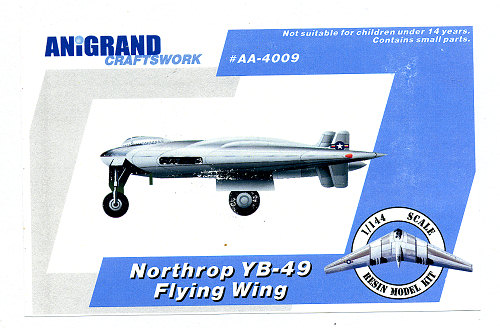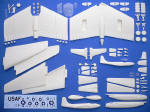
Anigrand 1/144 YB-49 Flying Wing
| KIT: | Anigrand 1/144 YB-49 Flying Wing |
| KIT #: | AA-4009 |
| PRICE: | $96.00 from www.NostalgicPlastic.com . Pay no US or Canadian shipping. |
| DECALS: | One option |
| REVIEWER: | Scott Van Aken |
| NOTES: | Resin. Includes XP-83, FH-1 and XB-43 kits |

| HISTORY |
In 1941, as it seemed Britain would fall to a German invasion, the USAAC opened up a competition for a very long-range bomber that would have to reach Europe directly from North America. Northrop and Consolidated were selected for the development of two prototypes that designated the XB-35 and XB-36. Numerous technical problems delayed both two projects which could not be ready for use in WWII. In 1946, the XB-35 finally completed and made its first flight. However, the propeller-driven B-35 was definitely outdated as it was too slow for the era of jet propulsion. The Air Force decided to authorize modification of two YB-35s by installing eight jet engines. These two aircraft were redesignated YB-49. The first YB-49 made a significant flight in 1948. It was proved quite successful until the second YB-49 crashed while performing speed runs at altitude. Flight testing revealed stability problems which could not be corrected with existing technology. The Air Force decided to order the B-36D to meet the requirement for a long-range strategic bomber. The YB-49 program was cancelled in 1950 while the first prototype was totally destroyed in an accident fire.
A couple of things of note. One is that once the program was cancelled, all surviving airframes were quickly destroyed in situ. This means little has survived of these remarkable aircraft besides some small bits and pieces. Secondly, the Northrop wings, even back then, were very difficult to track on radar, unlike the massive B-36, which was very easy to track. Finally, even though the B-36 was a better or actually more stable bombing platform than the flying wings, the decision to choose the B-36 was as much a political one as it was one of technology. Jack Northrop was not well liked by either the USAF hierarchy and had detractors in Congress (from whence all monies flow). Many historians think that it was Jack Northrop and not his plane that caused the final demise of the program. In hindsight, we can see that the plane had a tremendous amount of room for growth as the airframe could handle a wide range of power plants, whereas the B-36 was pretty much a dead end airframe and the last of the purpose built piston bombers (the B-50 was just a growth of the older B-29).
| THE KIT |
 This is another very nice Anigrand production. The image of the parts is a bit of non-reality as all the pieces there have been chosen for perfection and trimmed. Your actual kit may vary, but my experience with Anigrand kits shows that they are generally quite well done and frankly, I like them quite a bit. My copy has the usual air pockets on the tips of some flight surfaces and one wing has holes through the aileron as if someone had fired at it, but these are all a breeze to repair with either superglue or plastic rod/card if they are large. It is obvious from this kit that the prop driven XB-35 could be done as the only thing really needed to be changed is the center fuselage section and the addition of prop shaft housings and props. AMT did it successfully and I see no reason why Anigrand shouldn't give it a whirl. Like the AMT kit, the outer wing panels are two pieces, which really helps cut back on weight. The small finlets fit into holes already drilled in the upper and lower 'fuselage' section. The upper and lower fuselage sections also split the jet intake so some additional care will be needed attaching these. Perhaps a separate insert, as on the AMT kit would have been possible, but with Anigrand's technology such as it is, this might have created more area for those pesky resin 'balls' one often finds in constructs like that.
This is another very nice Anigrand production. The image of the parts is a bit of non-reality as all the pieces there have been chosen for perfection and trimmed. Your actual kit may vary, but my experience with Anigrand kits shows that they are generally quite well done and frankly, I like them quite a bit. My copy has the usual air pockets on the tips of some flight surfaces and one wing has holes through the aileron as if someone had fired at it, but these are all a breeze to repair with either superglue or plastic rod/card if they are large. It is obvious from this kit that the prop driven XB-35 could be done as the only thing really needed to be changed is the center fuselage section and the addition of prop shaft housings and props. AMT did it successfully and I see no reason why Anigrand shouldn't give it a whirl. Like the AMT kit, the outer wing panels are two pieces, which really helps cut back on weight. The small finlets fit into holes already drilled in the upper and lower 'fuselage' section. The upper and lower fuselage sections also split the jet intake so some additional care will be needed attaching these. Perhaps a separate insert, as on the AMT kit would have been possible, but with Anigrand's technology such as it is, this might have created more area for those pesky resin 'balls' one often finds in constructs like that.
The YB-49 is indeed a sweet looking aircraft and quite futuristic, even today. The entire upper cockpit section is clear resin as is the lower bombardier's position and the rear gunner's bubble towards the rear (though no guns or even mock-ups were fitted to this aircraft). The kit provides seats for all crew members and that is about it. Frankly, little can be seen inside the cockpit area once the clear bits are installed and masked off, so the lack of any major detail is not really that much of a concern. One will have to cram as much weight as one can get away with in the leading edges of the wing to ensure it won't tail sit. Though it looks like it won't need weight, my experience with the XB-35 in 1/72 scale showed that weight is needed.
Anigrand seems to like to add other 1/144 kits to these large planes and I'm very pleased that it does. This kit comes with three early jet aircraft; an XP-83, FH-1 Phantom, and XB-43. All are relatively simple builds with minimal or no cockpit detail, a clear resin canopy and the ability, as with the YB-49) to build the model with gear up. There is room in the nose of the XB-43 for the weight you will have to have to keep them from tail sitting. The other two will need to have cavities drilled out to accept weight or one could glue the model to a base or provide a tail stand. As usual, a few mold glitches will need fixed. My FH-1 has a wing with a hole in the tip that looks to have been caused by an unexploded 128mm shell! However, plastic rod will fix that right up in about 5 minutes.
There are two identical decal sheets to provide markings for these aircraft. The XP-83 and YB-49 are in overall unpainted metal while the XB-443 has the nose and forward half of all the flight surfaces in a light grey. The FH-1 is in overall gloss sea blue. Instructions are back to the photo-realistic versions and better reproduced than earlier attempts. You have two or three fully built images of each aircraft showing where the parts go. I personally prefer the line drawings as they are far more clear. Anigrand decals have proven themselves to be well done and to go on without any problems.
| CONCLUSIONS |
You know you want one. It is the perfect scale for large planes like this and will fit on any shelf with ease. Though a tad more complex than some of their other kits, the smaller kits supplied are a great way to get involved in building resin kits as they are simple, yet will allow one to exercise the full range of skills needed for building resin reproductions of any sort.
January 2008
You can get this kit fromwww.NostalgicPlastic.com and pay no shipping in the US or Canada.
If you would like your product reviewed fairly and fairly quickly, please contact the editor or see other details in the Note to Contributors.